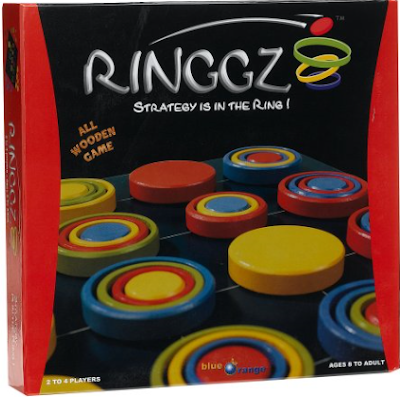 |
Ringgz |
Ringgz is a strategy game that will have you thinking in circles. This game is popular with teens and I like it myself! The more I play, the more strategies I think of and the more fun it becomes. As with many strategy games, the rules are fairly simple and straightforward.
All pieces are quality, solid wood, and the rings are brightly painted. The board (see left below) has 25 dots, each one is a "territory" where rings may be placed (see right below). There are four different sized rings and up to four can be played on any dot. Here is a sample of what the board looks like with and without rings:
There are 25 territories in total. To win a territory, you must have the majority color on that dot when the game is over. For instance, if there are three red rings and one blue ring, red gets the territory. If there are two reds and two blues, no one gets the territory because no one has the majority color. In the image on the right above, blue has six territories, red has five territories, yellow has three and green has five. Blue wins.
Object:
Win the most territories (by having the majority of rings/color on each territory) at the end of the game.
Set up:
Place the board between players. Each player chooses a color and takes all the rings of that color (12 each). Place the starting base piece (has all four colors) on the central dot.
Play:
Players take turns placing one ring per turn on the board. You can only place a piece on a dot that already has your own color or is adjacent to your own color. Here are the ways you can place your pieces:
- Place a ring on any free territory that is adjacent to a territory already containing your color.
- Place a base (large solid ring) on any free territory that is adjacent to a territory already containing your color. Place these pieces strategically. They can help block your opponent from going further in that direction.
- Place a ring on a territory where you are already present.
- Place a ring on a territory that your opponent is occupying that is adjacent to a territory containing your color.
Play until all the rings have been played. Count who has the most territories and declare the winner.
Try this:
Try this:
- Work on visual discrimination, spatial relations, figure ground, manual dexterity, logic, executive functioning skills, socialization skills, process skills, play and leisure exploration and participation
In the box: 12 rings each of 4 different colors, 3 bases each of 4 different colors, game board
Ages 8+, 2-4 players




No comments:
Post a Comment
Thank you for taking the time to comment.